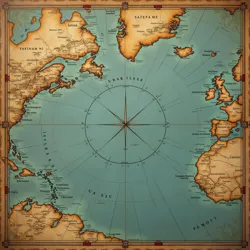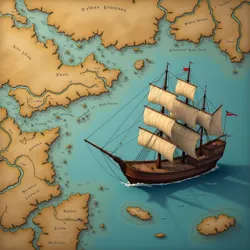Meridian Sea
 A preserved nautical chart from the Second Age showing major trading ports and sea lanes of the Meridian Sea, with detailed wind patterns and seasonal currents marked in traditional maritime notation
A preserved nautical chart from the Second Age showing major trading ports and sea lanes of the Meridian Sea, with detailed wind patterns and seasonal currents marked in traditional maritime notationThe Meridian Sea is a vast body of water that forms the southern boundary of Oleth, stretching from the western shores of the Sunspire Peninsula to the eastern reaches of the Thalassocracy of the Seven Ports. This crucial waterway has played a central role in the development of commerce, culture, and civilization across multiple ages, serving as both a barrier and a bridge between diverse peoples and lands.
Physical Geography
The Meridian Sea's unique characteristics arise from its position between major continental landmasses and its connection to the greater oceans through the Straits of Eternal Dawn. The sea spans approximately 1,200 leagues from east to west and varies between 300 and 500 leagues in width from north to south. Its waters are notably warmer than those of northern seas, influenced by deep underwater thermal vents and the regular flow of warm currents from the south.
The sea floor topology varies dramatically, featuring deep trenches that reach depths of over 2,000 fathoms in the Abyssal Maw, as well as vast shallow continental shelves that support rich marine ecosystems. The Coral Archipelago stretches across the sea's central region, comprising thousands of small islands and reefs that have historically served as waypoints for maritime traders and havens for the seafaring peoples of the region.
Maritime Climate
The Meridian Sea generates its own distinctive climate patterns that significantly influence the weather systems of southern Oleth and neighboring regions. The interaction between warm sea surfaces and cooler continental air masses creates predictable seasonal wind patterns known as the Meridian Trades, which have been crucial for maritime navigation since the earliest days of seafaring.
During the summer months, the sea experiences the phenomenon known as the Great Calms, when wind patterns shift and create vast areas of still air. This seasonal pattern has historically dictated trading schedules and naval campaigns, leading to the development of specialized vessel designs and navigation techniques among the seafaring peoples of the region.
 A traditional triple-masted trading vessel of the Meridian Sea, showing the distinctive curved prow and expanded sail configuration typical of ships designed for the region's unique wind patterns
A traditional triple-masted trading vessel of the Meridian Sea, showing the distinctive curved prow and expanded sail configuration typical of ships designed for the region's unique wind patternsHistorical Significance
The Meridian Sea has been central to the development of civilizations since the First Age, when coastal settlements first began to establish regular maritime trade routes. The legendary Pearl Road maritime network, established during the early Second Age, connected the wealthy ports of the Golden Bay with distant markets across the sea, facilitating the exchange of goods, ideas, and cultural practices that would shape the development of multiple civilizations.
During the Age of Migration, the sea served as a crucial highway for peoples seeking new lands and opportunities, leading to the establishment of numerous coastal settlements that would eventually grow into major urban centers. The development of advanced navigation techniques and shipbuilding technologies during this period laid the groundwork for the maritime dominance that would characterize later eras.
Maritime Culture
The peoples of the Meridian Sea have developed distinct maritime traditions and customs over millennia of seafaring. The Seaspeaker Guilds maintain ancient traditions of navigation and weather prediction, passing down sophisticated knowledge of currents, winds, and celestial navigation through generations of maritime practitioners. Their expertise remains highly valued even in the current Third Age, despite technological advancements in navigation.
The sea has also given rise to unique cultural practices and beliefs, including the widespread veneration of Thalassos, the mythological guardian of maritime travelers. Coastal communities regularly perform traditional ceremonies to ensure safe passage for vessels and abundant catches for fishing fleets, while maritime folklore has evolved into a rich tapestry of tales that continue to influence art and literature throughout the region.
Economic Importance
The Meridian Sea remains one of the most economically significant waterways in the known world, facilitating trade between the prosperous ports of Oleth and distant markets. The Inland Sea Trade Routes connect with Meridian shipping lanes through several major ports, creating an integrated commercial network that spans vast distances and connects diverse economies.
Major exports transported across the Meridian Sea include textiles and horses from the Eastern Steppes, timber and medicinal herbs from the northern regions of Oleth, and precious metals from the mountain kingdoms. The sea's rich fishing grounds also support substantial commercial fishing operations, with several species of fish and other marine products being highly valued in markets throughout the region.
Environmental Concerns
Recent centuries have seen growing concerns about the environmental health of the Meridian Sea. Increased maritime traffic and coastal development have impacted traditional fishing grounds and marine habitats, while changes in water temperature have affected the migration patterns of various marine species. The Council of Wardens has established several marine sanctuaries in cooperation with coastal authorities to protect vulnerable ecosystems and ensure sustainable use of maritime resources.
Modern Significance
In the current Third Age, the Meridian Sea continues to evolve in its role as a crucial artery of commerce and communication. The establishment of the Maritime Concordat has helped regulate international shipping and reduce piracy, while ongoing diplomatic efforts work to balance the competing interests of various maritime powers. The sea remains a vital link between peoples and cultures, its waters carrying not just goods and travelers, but ideas and innovations that continue to shape the development of civilization in the region.
See Also
- Carinor
- Inland Sea
- Sunspire Peninsula
- Maritime Concordat
- Thalassos
References
- The Maritime Chronicles of the Third Age
- Navigational Practices of the Meridian Sea
- Ancient Trade Routes and Cultural Exchange
- Coastal Ecology of the Southern Shores